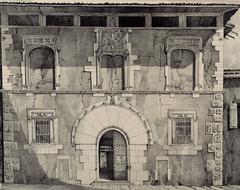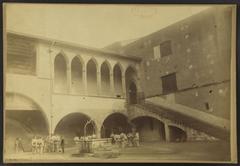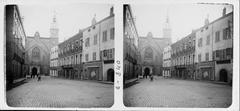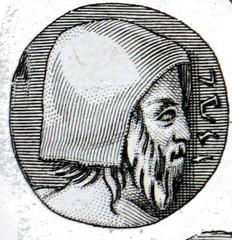Visiting Hours, Tickets, and Highlights of Muséum d’Histoire Naturelle, Perpignan
Date: 24/07/2024
Introduction
Nestled in the heart of Perpignan, the Muséum d’Histoire Naturelle de Perpignan offers visitors a unique blend of natural history, cultural heritage, and scientific curiosity. Established in the 18th century, this museum has evolved significantly over the centuries, starting from a modest cabinet of curiosities to becoming a comprehensive repository of natural history and biodiversity. Located in the historic Hôtel Çagarriga, a 16th-century mansion, the museum provides a rich architectural and historical context that enhances the visitor experience. This guide aims to provide a detailed overview of the museum’s history, visitor information, collections, and tips to make the most out of your visit. Whether you are a history buff, a nature enthusiast, or a curious traveler, the Muséum d’Histoire Naturelle de Perpignan promises an enriching experience for all. For more information, you can visit the official website.
Table of Contents
- Introduction
- History of Muséum d’Histoire Naturelle, Perpignan
- Visitor Information
- Collections and Exhibits
- Educational and Cultural Role
- Expansion and Modernization
- Preservation and Conservation Efforts
- Community Engagement
- Nearby Attractions and Travel Tips
- FAQ
- Conclusion
History of Muséum d’Histoire Naturelle, Perpignan
Origins and Early Development
The Muséum d’Histoire Naturelle de Perpignan traces its origins back to the 18th century. The core of its collections originated from a cabinet of curiosities established by the University of Perpignan in 1770. This cabinet was a collection of various natural specimens and artifacts, reflecting the scientific curiosity and educational aspirations of the period (source).
In 1835, the Société Philomatique de Perpignan, a learned society founded shortly before, took over these collections. The society aimed to create a comprehensive Cabinet of Natural History that would integrate its own collections with those inherited from the university. This initiative marked the beginning of a more structured and expansive approach to natural history in Perpignan (source).
Establishment as a Municipal Museum
The formal establishment of the Muséum d’Histoire Naturelle occurred on August 4, 1840, when the city of Perpignan purchased the collections from the Société Philomatique. The museum was initially housed in the former University building, providing a central and accessible location for the public and scholars alike (source).
Relocation to Hôtel Çagarriga
In 1900, the museum was relocated to its current home, the Hôtel Çagarriga. This mansion, dating back to the 16th century, was purchased from Raymond Çagarriga. The move to this historic building not only provided more space for the growing collections but also added a layer of architectural and historical significance to the museum itself (source).
Architectural Significance
The Hôtel Çagarriga is a notable example of 16th-century architecture. Originally owned by the Blanes family, it was transferred to the Çagarriga family shortly before the French Revolution. The building served various purposes over the years, including housing the revolutionary tribunal in 1793. In 1964, several elements of the mansion, such as a sculpted window and an iron staircase railing, were classified as historical monuments, underscoring its architectural value (source).
Visitor Information
Visiting Hours
The Muséum d’Histoire Naturelle de Perpignan is open from Tuesday to Sunday, 10:00 AM to 6:00 PM. It is closed on Mondays and public holidays. For the most up-to-date visiting hours, check the official website.
Ticket Prices
Admission to the museum is free, making it accessible to everyone. Donations are welcomed to support the museum’s ongoing efforts in preservation and education.
Guided Tours and Special Events
The museum offers guided tours and hosts special events throughout the year. These include temporary exhibitions, educational workshops, and community outreach programs. Check the museum’s event calendar for the latest information.
Accessibility
The museum is committed to accessibility, with facilities to accommodate visitors with disabilities. For specific accessibility needs, contact the museum in advance to ensure a comfortable visit.
Collections and Exhibits
The museum’s collections are diverse, encompassing specimens from various fields such as archaeology, zoology, mineralogy, and ethnology. One of the most notable items in the collection is an Egyptian mummy, donated in 1847 by Ibrahim Pacha after a therapeutic stay in Vernet-les-Bains. This artifact adds an exotic and historical dimension to the museum’s offerings (source).
Educational and Cultural Role
The Muséum d’Histoire Naturelle de Perpignan plays a significant educational and cultural role in the region. It offers a year-round program of temporary exhibitions and numerous educational activities designed to engage visitors of all ages. These initiatives make the museum a dynamic center for learning and discovery, fostering a deeper understanding of natural history and environmental science (source).
Expansion and Modernization
Throughout the 20th and 21st centuries, the Muséum d’Histoire Naturelle de Perpignan has continued to expand and modernize its exhibits and facilities. The museum now offers a permanent exhibition that provides a comprehensive overview of the biodiversity and geodiversity of the Pyrénées-Orientales region. Visitors can explore scientific displays that take them from coastal ponds to the Pyrenean mountains and the plains of Roussillon (source).
Preservation and Conservation Efforts
The museum is also involved in preservation and conservation efforts, ensuring that its collections are maintained for future generations. This includes the careful management of its historical building and the ongoing curation of its diverse specimens. These efforts are crucial for the continued relevance and impact of the museum in both the local community and the broader scientific world (source).
Community Engagement
The Muséum d’Histoire Naturelle de Perpignan actively engages with the local community through various outreach programs and events. These initiatives aim to raise awareness about natural history and environmental issues, encouraging public participation and fostering a sense of stewardship for the natural world. The museum’s free admission policy further supports its mission to make natural history accessible to all (source).
Nearby Attractions and Travel Tips
While visiting the museum, take the opportunity to explore other nearby historical sites in Perpignan, such as the Palais des Rois de Majorque and the Perpignan Cathedral. The city’s vibrant cultural scene and picturesque streets offer plenty of additional activities for a memorable trip.
FAQ
-
What are the visiting hours for Muséum d’Histoire Naturelle de Perpignan? The museum is open from Tuesday to Sunday, 10:00 AM to 6:00 PM, and closed on Mondays and public holidays.
-
How much are tickets for the Muséum d’Histoire Naturelle de Perpignan? Admission is free, though donations are welcomed.
-
Is the museum accessible for visitors with disabilities? Yes, the museum is committed to accessibility. Contact the museum in advance for specific needs.
Conclusion
The Muséum d’Histoire Naturelle de Perpignan is more than just a museum; it is a testament to the region’s dedication to preserving and understanding natural history. From its rich collections to its educational programs, it serves as a beacon for knowledge and cultural enrichment. Plan your visit today and immerse yourself in the wonders of natural history.
For more information, updates, and upcoming events, follow the Muséum d’Histoire Naturelle de Perpignan on social media or visit their official website.








